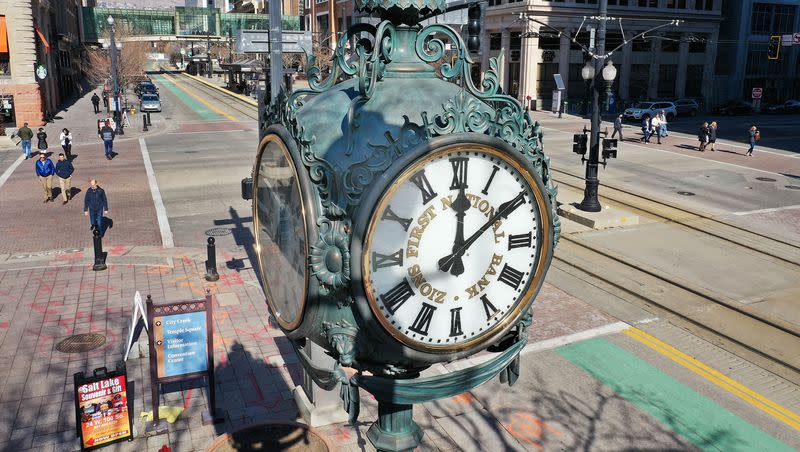Opinion: Stop the biannual time-change madness

- Oops!Something went wrong.Please try again later.
- Oops!Something went wrong.Please try again later.
If new House Speaker Mike Johnson wants to endear himself to the American public, he should immediately push a bill that makes daylight saving time permanent.
Such a bill already exists. It’s called the Sunshine Protection Act, and its sponsor is Vern Buchanan, a Republican from Florida. The Senate sponsor is Marco Rubio, also a Florida Republican.
Critics will argue this is an issue that captures public interest only for about a week twice each year. That’s about how long it takes for people to get used to either falling back an hour (in the fall) or springing forward an hour (in the spring). Otherwise, no one seems to care.
But research disputes the triviality of this biannual clock meddling.
Utahns will move their clocks back an hour at 2 a.m. this Sunday, Nov. 5. Even this seemingly welcome change will result in sleep loss, which, even in the fall, can lead to inattentive driving. It carries a host of other consequences, as well.
The Johns Hopkins Bloomberg School of Public Health quotes sleep expert Adam Spira, a professor in mental health, as saying, “The scientific evidence points to acute increases in adverse health consequences from changing the clocks, including in heart attack and stroke.”
Johns Hopkins also reports that the change leads to “heightened risk of mood disturbances and hospital admissions, as well as elevated production of inflammatory markers in response to stress.
A study published by Current Biology in 2020 found that the potential for fatal car crashes spikes just after the spring forward.
Indeed, the worst effects seem to come in the spring, when people lose an hour of sleep. But the whole idea of artificially changing times is disruptive to life and routines. This is particularly true of the parents whose children suffer from autism or other disorders in which daily routines, at exactly the same time, are important.
Related
Speaking of his bill, Buchanan told Tampa Bay TV station WFLA earlier this year, “This is the right thing, especially for Florida, but I think for a lot of states.” That list of states includes Utah, which passed a law in 2020 that would make daylight saving time permanent if Congress ever allows it and if at least four other Western states follow suit.
Currently, federal law allows states to make only standard time permanent, if they choose. Arizona and Hawaii have decided to do exactly that.
The idea of creating a daylight saving time originated with the Calder Act of 1918. World War I was raging, and the United States was copying Europe, which had established a summer time standard that would guarantee more daylight in the evenings, thus helping to conserve energy needed for the war effort.
The act also established five time zones in the United States. This was important for transportation. Railroads had difficulty handling schedules in a nation in which each city set its own time of day.
The time changing ended with the war, and confusion settled in again. A farmer named L.J. Van Horne of Chula, Missouri, summed things up in the Chicago Tribune in 1919: “Farmers where I live are disregarding the advanced time wherever they can. … When I start to market with my cattle, I set my watch up an hour, but when I get off the train and start back to my farm, I’ll set it back again.”
Franklin Roosevelt brought back daylight saving time during World War II and kept it year-round. But after that war, Washington again made it a local option. In 1966, Congress reinstated uniform time zones, and it also reintroduced daylight saving time. The nation went entirely on permanent daylight saving time for a year, beginning in 1974, because of the oil embargo.
After that threat ended, most of the nation has been observing the biannual time change, and griping about it, ever since.
That’s a long and convoluted history. It’s time to end the nonsense.
The National Conference of State Legislatures reports that 19 states have passed bills or resolutions urging year-round daylight saving time over the past five years alone. Earlier this year, 23 bills had been introduced in various states to do the same, but 15 bills were introduced to put states on permanent standard time.
Clearly this is a contentious issue. Last year, a poll by the Deseret News and the Hinckley Institute of Politics found 41% of Utahns in favor of year-round daylight saving time and 30% in favor of permanent standard time.
People seem to agree, however, that the nation should pick one and stick with it.
Last year, the Senate approved the Sunshine Protection Act unanimously on a voice vote. But the House never took it up. This year, neither body has considered the bill.
That’s unfortunate. It seems as if politicians should be better at recognizing a winning cause when they see it.

